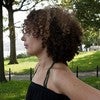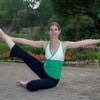Description
About This Video
Transcript
Read Full Transcript
I'm Ken Gilbert, I'm here at Pius. Any time to share with you a spine corrector class with these four participants. And we've been practicing a little bit. We'll see what happens in the next few minutes as we go into the five primary joint actions that the spine forward, flexion, extension, lateral flection rotation and circumduction rotating around a spot, a pivot point or a spine point. So when I teach, I like to refer to the high point or the center core, the bottom of the sternum, bottom of the rib cage in the back. And it's a place that if we stabilized, it's right at the top of the lumbar. And at the bottom of the thoracic it engages the diaphragm a little bit or will also engage the QL as well as the so as, so we play with that.
And with the spine corrector, we have this prop to lean into, to fall into or to reach into. That allows us a safety feeling of comfort. So we'll be playing with that today. So we're sitting up on this, on this corrector to start. So we're starting to dropping the pubis forward. Sitting up on the sits bones, lift the sternum, reach the arms forward, and then out to the side, palms are down and we begin with our rotation. All of us are in turnout. So we're open at the hips
Bring the feet forward and then shift your weight forward and walk your feet enough so that you bring your sits bones on to the lip, right onto the very lip of that Ridge there. Elbows out to the side with the sternum and then contract your pubis back to your navel or up to your navel.
And arms circle and butt, belly or pubis enable.
Lower belly pulls in and up. Some of this has to do with the clothing that you're wearing. If it's slippery on your skin, and
Keep your head up so there's no falling back. Keep reaching the shoulder blades forward. Head up and then roll back to the tips of the shoulder blades. And then from there we're going to roll up into the contraction here and then roll back.
So avoid the head falling back. Keep the head right on top of the spine. Arms are in front of the head or the [inaudible]
Four, three, two. Now bring your arms over, head, arms are alongside the phase and then arms come up and then roll up.
Otherwise you use your arms and reach to come up onto the lip. Yeah, show off the two of you just showing off beautifully. Yes, you did. Yes, you did. Do it too. Go ahead and put the stick off to the side. Take hold of the frame here and then lift the hips up and then pull the sits bones down into the crevice. We'll do that again. Push up, peel up so you're peeling up belly and then hinge back flat back or lower back extension. Should have two more time. Come on and peel up. Pubescent and beautiful right there. Rolling through the spine. Intervertebral articulation and then sitting into the crevice.
And one more time, press up and peel up. This time we're going into the crevice. Lower back and sit into the crevice. But stay with the legs here first. So we're here. Arms reach out in front and roll back to the lumbar.
Now keep the contraction at the bottom of the sternum. Roll back into the short tips of the shoulder blades. Have heads had Lesley head. Now pull the shoulder blades forward so you're expanding your bathtub wide. Now pulse the tips out or tips of it. Let's think of them as epaulets.
The outer tips of your shoulder blades. You pulse forward? No, you're in the bottom of the sternum. Yes. Nice. Four, three, two and roll up. Then all the way to sit, lower belly getting up and let's do this a few more times and lengthen up first and pubis enable rolling back into the Lumbar, then into the lowest rib, then into the shoulder blades. Head stays up and then rolling up. Lower belly pulls in and up. Since we practice the other day, everyone's gotten a little better with the head. We don't need the strap. You remember, we need the strap later earlier. So let's roll back again. Lower belly, lower belly tips of the shoulder blades. Hit Up.
Now this time, take the thoracic extension there. So we're at the bottom of the rib cage. We're now out that space between the shoulder blades. Pull the shoulder blade at the end of the corrector and then reach them away. Pull into the corrector and reach away.
Play with the relationship of your Chin to the maneuvering them so you do not want the head to be forward too far or back too far. We're playing with the relationship of upright spine even though we're back over the barrel of the corrector at last one here, and Ben Roll up starting at the bottom of the sternum. Roll up all the way to sit. Nicely done. Let's do this now with the stick we'll play with still with the parallel legs. So we're here and
Open the shoulder blades wider so you feel the vertebra into the ark and go over four more times four and three. Keep the chin relationship to the maneuver in the bottom of the throat. Two and last one and then arms come up and then roll up. What I've learned, particularly in doing the corrector is that there might be a little sensation stinging and that's part of the Maya Facia opening up. So you get little stinging in the, in the tissue at the lower back. Yes or no? No, no I do sometimes. Sometimes I don't. Depends on how open I am that day.
So widen the shoulder blades and roll on back. Say from first, then lowest rib tips of the shoulder blades, RMC ears and roll on over four counts. Maybe going over a little further this time. Keep reaching the tips of the shoulder blades towards the ceiling. If the chest expansion and a back expansion at the same time and one more, and then come on up arms first and then roll up. Or just remembering something that we did last. We can, I like that.
Let's go ahead and do that so we can open up the neck. Put the stick off to the side. This is different than being on the lip. You're gonna place your sacrum somewhere along the way of the, you want the sacred VUB across or the across the lip. So we're here, we can do it with bent knees and legs and then allow yourself to be in that, that thoracic extension here. Bring the arms alongside the face and then roll back. So you want the head to not fall back. You want to feel it supported? Yeah, to we have that.
Drop your pubis towards your heels so you're opening up the lower back and pulse four, three, two, bring your arms up and reach the frame of the corrector. Scoot is your sacred more toward the crevice. And that's going to allow you then to roll up a little bit more, roll up a little bit and we'll do the same thing. So we're seducing or creating a safety of the cervical spine going over the corrector. So you're further back on the corrector. Yeah, and here we are, arms over the chest and then arms alongside the face and reach. Widen the shoulder blades as you go back over the corrector, you go further back this way. Yes.
Chin is in relationship to them and new BREEAM. Bring the arms up over the shoulders and roll up.
This is an important to be careful. We don't need to go too quickly with this chest.
We're now getting the chin to be in relationship to the maneuvering the throat. Bring the arm right arm across the hip, so right arm across to the left hip
What's been curious to me is that this really is the base of the neck. If we're careful between the bottom of the sternum, the bottom of the rib cage, somewhere there, finger of the head, like a tootsie pop and the stick of the spine. Then we put the head on top. It regulates a lot more. Less tension. Yeah, it got the image. Yeah, the tootsie pop. All right, so then let's readjust to come back into the crevice and then let's go to diamond. So placing the feet here allows you to sit up a little bit higher, particularly for guys. It gets us out of our lumbar a little bit. So from here, let's play with the same thing we did. Let's use the a strap this time. Does it start warming up that connection, warming up that connection. Let's go with Tutu from the middle of the strap.
We're doing all right. I'm feeling warmed up. Yeah, with the sternum, drop the pubis and roll back to the sacrum. I remember you don't want to tilt. You want to open up the lower back and as we as when I was doing my study years ago, now this is the most unflattering position for me to be on camera because I'm going to look really thick and wide and rolling back to the lowest rib. You see? I'm just getting thicker and wider. You're all doing it too, but they don't get to see it and then widen the shoulderblades here, here, here, head, head, head, head, head, head, head, head, head. Yeah. There's that tootsie pop. Let's do some pulses at the bottom of the sternum for three. Now the pubis and
Lower belly pulls in and up and let's go over four ch regulate your head, neck and shoulders. You have to learn to strengthen that connection. You do not let the head fall back, but instead you're regulating or y back so the tootsie pop stays over the spine, even though the spine is bending back. Bring the arms up over the shoulders and then roll up. Head, neck, shoulders and arms, all the way up to upright fit. I'm going to watch that happen and see where we are and rolling back. Say, come first. Roll back to the sacrum. Drop the pubis rolled back to the lowest rib.
Roll back to the tips of the shoulder blades. Head stays up, head stays. Wait, wait, wait, wait, wait. Come back up. Come back up. There's that eagerness to go over and I get it. However I want to see this first. Really activate this bottom of the sternum. Now, arms, head, neck and shoulders go over. Yeah, arms alongside the face. Yep. There you are. Now go over four counts for four breaths, three and two.
So each of you have your own degree of flection into this extension and fascinating to watch, even though it's an extension, you have a spinal flection going on. Beautifully done. Arms come on board with the shoulders and then rolling up head, neck, shoulders and arms all the way up to [inaudible]. Yeah, so that's nice to have for demonstrations of different flexibilities or ranges of motion. I like that. Let's play with this. Now we're here. Let's go stay with the Tutu and
As you feel comfortable, bring the arms up and roll up shoulder blades wide back, wide roll up. Now the arms come up and rounding over. So we're creating a progression that all evolved with all of you here and now. Roll back sacrum and then lowest rib. Keep the strap, taught the shoulder blades wide, arms over shoulders as you go over alongside the ears and going over all the way, your own range of motion.
I'm bringing the arms up and then roll up into that frame and then roll away all the way up into a vertical set. So we played with this the other day. I don't wanna play with it now, so let's go back and do a hinge. So the Nora contracting back hinge and come up and hinge for this is the extension. Whereas before we were doing a full reflection to come up. We're doing the extension to come up, widen the shoulder blades two more and one lengthen up and round over. Now Rolling back, rolling back.
Sacrum, lowest ribs, tips of the shoulder blades, arms to face and ears. And then roll on back. Now find your extension and come up and the extension and round. Oh over and roll back. Sacrum lowest rib tips are the shoulder blades, arm, foot, face, and go over.
So find your extension and come up in the extension and then round over a lot of work for the extensors of the lower back, middle back. And let's just come up just to come up. I want to play with this another way too so we can go back in the hinge and we can pop forward in the hinge back pop forward. So we're learning how to use the QL in a unique way in opposition to the pubis. Yeah, so let's do that four times just for fun, just to see how we can do with that agility and avoid any rounding or folding.
Lengthen here.
We come across shoulder blade to shoulder blade. Let's just mark it and then roll up in the rotation. And then to center, let's do it on the other side. Rotate first, roll back on that side of the spine. Come across shoulder blade to shoulder blade and then roll up on bat rotation and then to center. Yeah, so let's play with that. Just give it the breath now and
I know I am inconsistent that way sometimes. What does he mean two more times on each side? Two more times on one side. What does it mean? What does he mean? All right,
Then you come up staff it. Yeah.
Chest head. This time, pelvis, chest had stayed there. Let's reach over four in three lifting up on your one side to lengthen on the opposing side and one keep the frame of the head to the shoulders as best you can and come out pelvis, chest, head and switch over. Pelvis, chest, head. Then over four and three and two and one and coming up switch hands. We're going to add a hip lift and go over five bend for now, lift the hip and then pull the hip into those Krebs.
Lift the hip and pull it into the crevice. This is going to tend to get into the neck and shoulders, so be careful that you keep the head behind the arms so you're working in the QL, sitting up on your fifth bones, a little bit more outside. Bend over further, four and three. Drop the hip into the crevice, two and one. Let's go over as far over as you can and then lift pelvis. Chess said, use attraction of the strap. Stabilize your shoulders and over side bend
That'll lower back and coming up.
Keep the head engaged first. We're not going all the way into the thoracic. Going back to the tip of the shoulder blade and coming up and one more to the tip of the silver blade and there it is. And coming up pelvis. Chest had to return either side.
She's say band and coming up.
So I'm gonna change the side bend and we'll add it back in. So we're here going into the rotation and I'll go back.
And as you see Karen's going all the way opened into the chest and that's the good thing to be able to do. And then come up to the five Ben here and then up. We'll do that on the other side. Now we'll put everything together in some unique ways. You'll see. And then let's go back and, and then coming up to the other side and forward, come to center and go back. Open the chest if you can. Coming up side, bed and forward, side bend and back, side bend, forward side bend and back and side bend, forward and side bend and back, side bend and come up. Pelvis, chest, head.
So you see everybody has a different range of motion through the shoulders, which is fun to play with. And then side bend forward. First sideband and back and back. Side Bend. Opening your chest. As you can remember, that's very personal. Finding that range of motion that feels safe for you and your shoulder girdle and side bend. And let's come up. So let's do the full circle.
Low dock circumduction so you start with the forward contraction. Let me just show you cause I want to watch you do it. That way I won't be in the way side bend first all the way and then back all the way. Let's keep the hands position your side bend and then forward. The other way would be side bend and back. All the way side bend. Go to the floor if you want to.
If depends on if there's all choice at this point, how do you feel safe because we're rotating now on that pivot point. So let's start with the four reflection. Sideband coming front and then back. Sigh, bend and pull reflections. Go again. Three more times that direction. Sigh. Bend. Yes. Awareness of fitting in sits bones. Yes.
And one more the other way for the other way. Side band into the extensions. Yes. And side bend into the flection. So there we go. We're playing with all sorts of spinal articulation and extension. I think that was the second one. That way. Yeah. Yeah. Two more please. It's very personal at this point. How you feel confident and safe.
Comfortable as well and forward and last time and then coming to up, right? Yeah. So we've done full reflection, extension, lateral flexion and extension. We've done circumduction and rotation. So we'll go over the barrel from here. So put your straps off to the side,
See you're pointing your feet, then you're lowering the low. Pull the lower belly in and up. Pull it in and up as you lift the peel up off the corrector. So you're going into an upright candlestick pose or something of the shoulder stand. And then peel the spine down. Keep your leg straight up in space and peel up.
Opening up the front of the hips and peel down. So here we're getting two different joint actions. Here's the flection of the lower back and here's the extension of the lower back. Inhale up, exhale down, and inhale up. Exhale down. Two more. Inhale up, exhale down. And one more. Inhale up and exhale down. One of my favorite things here is to open up the front of the hips, the SOS. So be sure that your chin is away from it and maneuver IOM that you're not pressing it into the chest.
Be sure that your lower belly lower back is pressed into the corrector for now so that you're getting an extension. Be sure that you're pulling yourself into the characters so that there's not a space between your, your mid back and the current corrector itself. Reach the legs down a brush, the soles of your feet on the lip. You'll find it and then reach out and bring the legs up. We're just finding the range of motion first. That's one direction.
And then reach the lake's down. We'll do the repetitions with the breadth of the minute. Then brush the feet at their lip. So let's start here at legs as straight up. So inhale, bend the knees, exhale and brush. Extend the legs out. Inhale, bring the legs up. Exhale, bend the knees. Inhale, reach out. I've just changed the breath and extend. There it is.
Lift up and bend the knees and reach out. Brush and Alvin the front of the hip. Come up and then bend the knees and reach down. Brush the lip, extend the legs and come up and bend the knees. Let's do this one more time. Brush the lip, lift the legs and then bend the knees and then we do the reverse. Extend the legs up, reach down.
Then the knees brushed the lip and coming up. Extend the legs. Great. So last stretch here to open up the front of the hips as best you can, keep the inner thighs together, straighten up, reach out, bend the knees and come up. Last time you stand the legs, reach out, bend the knees and come up. Let's do a few splits here cause we have that opportunity. We're in this position recently, like straight up. Bring the right leg over the chest and the left leg away from the the or closer to the corrector. And now we're going to pulse that
So drop the sacrum into the corrector again and let's just do a little bit lower back. Uh, ex extension or a stretching here. So we're going inflection. Bring the legs over the chest so we're not in a position of reaching up out of the sitz bones toward the ceiling. And then peel the spine onto the corrector all the way down through. We're articulating through the lower back. And let's go ahead for that.
Stretch the hips stretch. Reach the lakes down toward the lip, down toward the lip, and then bring the legs up again, hip flection, and then bring the legs to flex over the chest and then peel away from the corrector. We're creating a little bit more. Lift those hips up with the hips up, lift the hips up, and then peel back to the corrector. And then over one more time, like reach down toward the lip. [inaudible] so this is all preparation for the dismount. So is everybody ready? So you're choosing your own dismount. So we're going to dismount to the fifth position or dismounting to a position. So we're s ending ending the session here. So ready to begin. And
Right. Thank you.
Comments
truly wonderful cueing, perfect for any level really.. beginner to advanced.
I enjoyed how each movements progression was carefully choreographed and executed.
You need to be a subscriber to post a comment.
Please Log In or Create an Account to start your free trial.




















